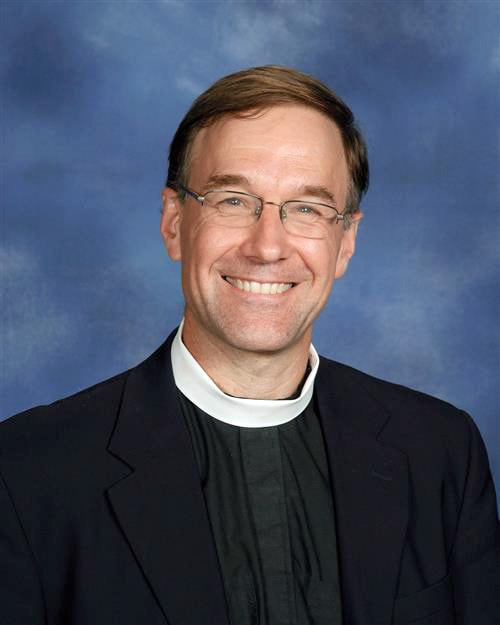|
Most years, Easter morning is the highlight of the whole year for me. The Church is packed, including lots of kids who make their own joyous noise to the Lord. The music is glorious. Everyone is in a good mood. And we celebrate the good news of great joy that death could not hold Christ, that Christ is risen, that Christ is alive. And to that, we always say, for the first time in weeks, “alleluia, alleluia!”
I look forward to Easter every year, but this year was going to be extra special. My parents were going to join us. They planned to arrive late yesterday, and I was going to see them for the first time since Thanksgiving at this service. Things have turned out to be quite different than any of us expected when Lent began seven weeks ago. This Easter is happening in the valley of the shadow of death. Many of us are mourning. Many of us are isolated and afraid. None of us know what the future will hold. The reality of life in the face of the covid virus is not at all what I associate with Easter. This seems like more of a Good Friday moment. But that is not so different from how the first Easter began. What we know, as our Gospel passage begins, is that Christ has in fact already risen. But Jesus’ disciples did not know that yet. They were grieving their crucified Lord. They were hiding in fear for their lives. They could not see a way forward. Mary Magdalene was braver, but otherwise not much better than the others. Mary didn’t have any more hope than they did. Mary didn’t anticipate resurrection. Mary wasn’t looking for her risen Lord. Mary just wanted to grieve as close to Jesus’ body as she could get. On that first Easter morning, Christ was risen. And, as that first Easter morning dawned, Christ’s followers didn’t feel any resurrection joy. The big news of that day was Christ’s resurrection, of course. But part of the story, the part that speaks to us right now, is the slow process by which Mary comes to recognize her Lord and to experience Easter joy almost despite herself. As we meditate on Mary’s story on that first Easter morning, we can also see it as our story, our invitation to discover Easter joy in our difficult time. God starts working on Mary right at the beginning. Mary shows up at the grave and sees that the stone blocking the entrance to Jesus’ tomb has been miraculously removed. I never thought much about that stone. But one of the early Christian fathers named Peter Chrysologus pondered why the stone was removed. Not so Jesus could get out, as I had always assumed. Jesus didn’t need any help. Jesus could appear wherever he wanted. We’ll hear stories about Jesus doing just that over the next few weeks. No, the stone was not removed for Jesus. So why? Chrysologus answers that the stone was removed for Mary. The stone was removed so Mary could see that the tomb was empty.[1] The stone was removed as an act of grace aimed at restoring hope to a grieving woman. It is a comfort to think that God removes obstacles to our faith, just as God did for Mary. But we need to keep going. We need to keep going because this first grace moment doesn’t work. Stone or no stone, the empty tomb does not reveal anything to Mary. With the empty tomb right in front of her, Mary literally runs in the opposite direction. Sometimes we do exactly the same thing. God invites us into relationship with the risen Christ. God nudges us along by removing some of the stones strewn in our way. But faced with Christ’s resurrection, we all too easily assume it just means someone has stolen the body. Thankfully God wasn’t done with Mary. Something drew Mary back to the tomb. Mary still didn’t go in. But Mary had the wisdom to recognize that more was happening than she yet understood. That, I think, is the first stirring of faith, that sense, however ill-defined, that God is at work even when life seems bleak and hopeless. So there Mary stood, just outside the tomb, unable to see God, unable to walk away, stuck weeping in a complicated mix of despair and just a little bit of hope. Finally Mary looks in. Mary turns away. Jesus Himself appears. And still Mary is blind to the presence of her risen Lord. The story goes on. And on any other Easter, we would go right on with it. But this Easter we need to pause at this most poignant moment in the entire story. Because this is the good news of resurrection that many of us need to hear right now. Christ didn’t rise because his disciples gathered together in great faith and with great joy to celebrate the good news of resurrection in the kind of Easter celebration we have most years. Christ rose, and his terrified disciples had no idea. God opened the way for them to enter Christ’s tomb, to see that it was empty, to connect what they were seeing with their own eyes to everything Jesus had told them. And they remained blind to the resurrection. The risen Christ stood right in front of Mary, quite possibly the person who loved him most of all, and Mary could not see him for who he was. The good news of Mary’s encounter with Christ is not so much that she finally recognized him. The good news of Mary’ encounter with Christ is that Christ was there, with her, even when she could not yet see. That is good news we can celebrate this morning. The good news of Easter is that Christ is risen. Christ is alive. Christ is with us. That good news is true no matter how we feel, no matter how blind we may be. Now, at last, with some relief, we can go on to the end. Jesus calls Mary by name. Mary sees Jesus for who he is. Mary sees that the person she thought was a gardener was in fact her risen Lord. There is an Easter invitation to us here. We, too, can learn to see Christ in the person right in front of us, to see Christ in the gardener, or the nurse, or the Post Office worker, or the person delivering groceries or the family member we share space with. Christ is all around us all the time, blessing us often through people in our lives who may not even know that they are acting as Christ’s hands and heart in our world. And having recognized Jesus in a place and person she would never have expected, Mary experiences resurrection joy. And Mary rushes back to the disciples once again, this time to share not her fears but her restored faith and hope. Mary’s story on that first Easter morning reminds us that Christ’s resurrection does not depend on how we feel on any given day. It is the opposite. Christ’s resurrection makes it possible for us to find joy even in times when sin and death seem to prevail. Because Christ defeated sin and death, and Christ invites us to share in his victory. And so on this day, which may seem bleaker than most Easters, I invite you to look around for glimpses of the resurrected Christ. And for Christ’s glorious resurrection, we can all give joyful thanks. Alleluia, alleluia! Amen. [1] Ancient Christian Commentary, New Testament 1B: Matthew 14-28, 2002: 306.
1 Comment
Elizabeth Whitcomb
4/21/2020 03:18:21 pm
Thank you especially for the paragraph that reminds us that we can (and should) see Christ in the person right in front of us. So many people are Christ’s agents and we fail to recognize this.
Reply
Leave a Reply. |
Rector
Rev. Dr. Harvey Hill Third Order Franciscan Archives
July 2024
Categories |


 RSS Feed
RSS Feed
